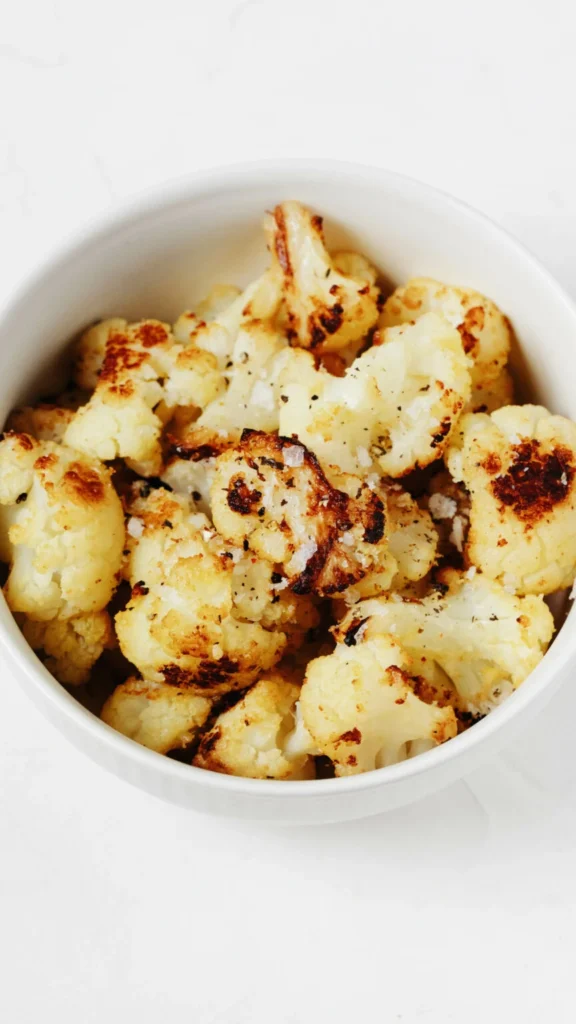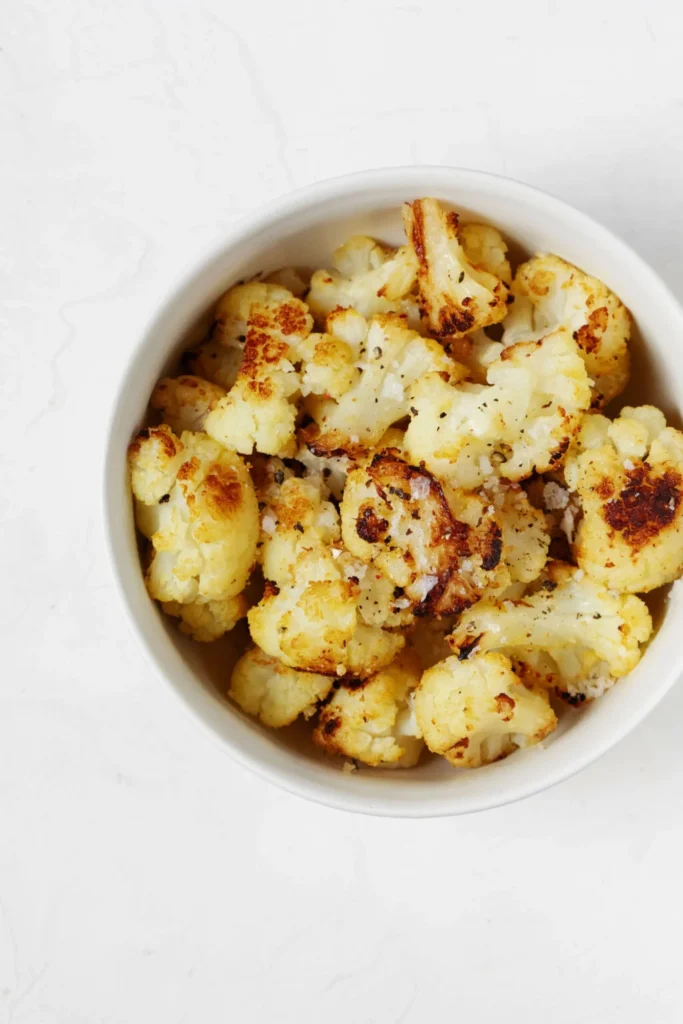I’ve been sharing some simple veggie side recipes lately that can help you quickly put more veggies on your lunch or dinner plate.
This is one of my easiest vegetable garnishes.
While writing Vegetarian Week, I had an internal debate about including my frozen broccoli.
These broccolis are precisely what they’re called — store-bought, frozen, roasted broccoli.
It’s ridiculous to include them because they don’t even have experience.
But the truth is, I did it every week during my clinical residency. The whole point of this cookbook is to capture the weekly meal preparation strategies that have helped me get through my busy time.
These roasted frozen cauliflower recipes are easier to start with than the broccoli recipes from Vegetarian Week, but not by much.
These florets are salty, slightly cheesy, and delicious – especially considering how easy they are to make!

Praise frozen vegetables
Nutritional choice
The public’s perception of frozen vegetables is changing. I see more and more articles affirming their nutritional value.
However, until I trained as a dietitian, I thought that frozen vegetables were less nutrient-dense than fresh vegetables.
If you have similar thoughts, you may find that commercially frozen vegetables are just as nutritious as fresh vegetables—sometimes even healthier.
This is because most commercial frozen products are picked when they are most ripe. The vegetables are then quickly cooked—usually blanched—and frozen.
Blanching is a quick cooking process that preserves most of the nutrients of vegetables. Vegetables arrive in the hands of consumers in such a way that they preserve their nutrients at their most ripe.
Conversely, fresh produce often has to travel a long distance to reach consumers, especially those not locally purchased.
As a result, vegetables sold fresh are sometimes picked before they are ripe, and at this point, they have yet to reach nutritional maturity.
At other times, they may lose their nutrient density during the long transition from harvest to sale.
Recent studies (1,2) have shown that frozen fruits and vegetables are comparable to fresh fruits and vegetables, sometimes with higher concentrations of nutrients.
There are exceptions, of course; the beta-carotene content in frozen vegetables is usually lower, and some antioxidant activity may be affected by freezing (3). In general, compared with fresh vegetables, frozen vegetables have advantages.
Now, that fresh-frozen comparison may change if one compares commercially frozen vegetables to locally grown fresh vegetables picked at their peak of ripeness.
But many of us can only sometimes access local, in-season, most mature produce.
If buying frozen food is the most sensible, feasible, or convenient option for you at any time, then you can rest assured that it won’t cost you any essential nutrients. In terms of some nutrients, this can be advantageous.
Convenient choice
I like to eat seasonally and support local farmers whenever possible. However, I often find it difficult to buy or prepare fresh vegetables from scratch.
For example, during my clinical training, I had to prepare three meals for each day of the workweek. Considering protein and a balanced meal, I can only spend a little time on vegetables.
Frozen vegetables were lifesavers at that time. (Incidentally, that year was also the catalyst for me learning to bake frozen vegetables in the oven instead of just cooking them in the microwave.)
Last fall, I worked at my clinic for a long time and felt drained. Once again, frozen vegetables helped me.
They allow me to eat a wide variety of vegetables without causing me any stress. They wouldn’t let me buy beautiful fresh produce that would spoil because I couldn’t find the time to cook – always a big regret.
The strategies I share with clients are usually developed through personal experience.
Over the past few years, I’ve recommended frozen vegetables to clients who complain they don’t have time to prepare vegetables to eat with their meals.
Sometimes, my clients express surprise; they want developers to tell them fresh is best.
Instead, I told them it was perfectly fine to freeze if they wanted to.
From a texture and taste standpoint, fresh vegetables are usually preferable to frozen vegetables.
But sometimes convenience is all that matters. During that time, my best friends were frozen broccoli, green beans, mixed vegetables, and frozen cauliflower, which was phallic.
A quick word on food safety: Although frozen vegetables have been quickly cooked before they are frozen, following the instructions on the package before eating is essential.
In this case, oven baking is a way to heat the florets sufficiently so they are safe to eat.
How to roast frozen broccoli
Technically, roasting frozen cauliflower flowers is as simple as placing them on a non-stick pan, parchment paper, or a baking sheet lined with tin foil, transferring them to a hot oven, and baking them through.
I like to add seasonings to make the finished florets taste good and have a nice texture. Here’s how I did it.
Step 1: Roast “naked” (i.e., unseasoned) cauliflower for 15 minutes
First, you don’t need to defrost the florets before roasting. They go straight from freezing into the oven. That’s part of what makes this recipe so easy!
In the first step of this cooking process, you will roast the cauliflower “naked” or “dry” for 15 minutes.
In other words, you can cook the florets without adding any seasonings. Add oil to the baking sheet if you don’t use a non-stick pan.
The key here is to defrost the florets and let them melt before cooking them in the oven.

Next comes the fundamental “baking” part of this recipe.
Step 2: Add olive oil and seasonings
After roasting for 15 minutes at 425°F / 220°C, you can remove the cauliflower from the oven and add some seasonings.
The seasonings I use, which I will share in my roasted frozen cauliflower recipe, are:
- Garlic powder
- salt
- Freshly ground black pepper
- Vegetarian cashew Parmesan or nutritional yeast
I’m looking for cheesy, salty, salty, and garlic flavors.
Of course, you can also choose a completely different flavor. For example, I mix roasted cauliflower with turmeric, ground ginger, and Madras curry powder.
It’s also fun to grill the florets with hot sauce and vegan butter, which is Buffalo-style.
Add the seasonings you need to the florets and stir well.

Salt, pepper, and vegetarian Parmesan cheese (or nutritional yeast) give the florets a salty, salty, and “cheesy” flavor.

When the flowers are done roasting, they should be brown on the outside and very soft.
Return the florets to the oven and bake for another 15-20 minutes or until they are crisp and golden brown around the edges.
Step 3: Service
I like to eat broccoli right out of the oven. They’re delicious as they are.
However, you can add extra flavor with any of the following:
- Freshly squeezed lemon juice
- A few tablespoons of Greek vinaigrette or easy champagne vinaigrette
- A small amount of white or balsamic vinegar
- A handful of chopped fresh herbs
- Dijon lemon tahini or green tahini
- Roasted pine nuts (or other roasted seeds or nuts)
- crumbs
You can add these ingredients to a baking sheet or scoop them onto each serving of broccoli.

Can I make my frozen broccoli?
Yes, you can. I’ve never done anything like this, so I don’t have inside information, but I know it’s possible. Check out some instructions here or here.
Meal preparation and storage
Once ready, the roasted cauliflower florets can be stored in an airtight container in the refrigerator for up to four days.
Technically, you can refreeze it and reheat it. It’s safe to do so. However, I tried it, and the texture is starting to deteriorate, so I recommend using it within four days of baking.

Ingredients
16 ounces of unthawed frozen cauliflower (455 grams)
1 tablespoon olive oil, plus a little for the baking dish
1/4 teaspoon garlic powder
salt
Freshly ground black pepper
1-2 tablespoons cashew Parmesan cheese (according to taste; Nutritional substitute yeast)
Optional: Freshly squeezed lemon juice, fresh, chopped parsley, vinaigrette, tahini, chopped nuts or seeds (for finishing)
Instructions
- Preheat the oven to 425°F / 220°C and line a baking sheet with tin foil. Alternatively, use a non-stick baking sheet. Drizzle olive oil over a piece of foil or baking sheet and rub around with your fingers or a pastry brush. For the first 15 minutes, the cauliflower should be cooked without oil. This small amount of oil keeps it from sticking too much.
- Transfer the frozen florets to a baking sheet. Bake the florets for 15 minutes. At this point, they’re no longer frozen but haven’t been roasted yet. Drizzle a tablespoon of olive oil over the florets, then sprinkle with garlic powder, a pinch of salt, a few circles of freshly ground black pepper, and cashew Parmesan or nutritional yeast. Use a spoon or spatula to mix the petals onto the sheet.
- Put the flowers back in the oven and bake for another 15-20 minutes or until browned and tender.
- Add any toppings you like and serve.

It’s an easy recipe, but you might be glad to have one when you’re tired and don’t have time to buy fresh produce. Your dinner will be better if it has tasty, nutritious vegetables.
I hope the frozen cauliflower will save you, as they have saved me many times. Enjoy!


